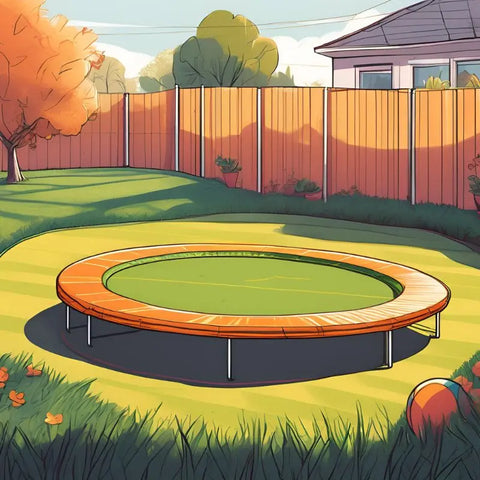Yes, you can put a trampoline on artificial grass! While it might sound risky for your pristine fake lawn, with proper preparation and protection, it's absolutely doable. Stick around as we bounce through everything from choosing the right spot to protecting your investment - your artificial grass and trampoline can be best mates.
The Pros of Trampolines on Artificial Grass
Low Maintenance
Unlike natural grass, which can turn into something resembling a muddy festival ground beneath your trampoline, artificial grass stays pristine year-round. No more battling with dead patches or mud being tracked through the house after a jumping session.
Consistent Surface
Artificial grass provides a stable, even surface that won't develop divots or holes over time. This consistency helps maintain the trampoline's stability and ensures safer bouncing conditions throughout the year.
All-Weather Use
Much like a proper British postman, your trampoline setup will be ready for action in almost any weather. The artificial grass drains well and doesn't get muddy, meaning more bounce time for the whole family.
Potential Cons and Considerations
Damage to Artificial Grass
While modern artificial grass is tough, the weight of a trampoline can cause the fibres to flatten over time. Think of it like leaving a heavy garden furniture set in one spot for too long - you might end up with some permanent compression marks.
Trampoline Stability
Proper anchoring is crucial when setting up on artificial grass. You'll need to ensure the trampoline is secured firmly, as the surface might not provide the same natural grip as regular soil.

Choosing the Right Artificial Grass
High-Quality Fake Lawn
When selecting artificial grass for under your trampoline, opt for varieties with a dense pile and proper drainage capabilities. Look for turf with a pile height between 30-40mm for optimal support and longevity.
Preparing Your Artificial Grass
Levelling the Ground
Before installation, ensure the base beneath your artificial grass is properly levelled. A wonky trampoline is about as useful as a chocolate teapot, so take time to get this step right.
Maintaining Your Setup
Regular maintenance will keep both your trampoline and artificial grass in top condition. Brush the turf occasionally to prevent matting, and check the trampoline anchors regularly - especially after those enthusiastic weekend jumping sessions.
Alternative Solutions
If you're concerned about damage to your artificial grass, consider an in-ground trampoline installation or creating a raised platform. These options can help preserve your artificial lawn while still providing all the bouncing fun.
Installation Tips for Success
Ground Preparation
Before laying artificial grass under your trampoline, ensure proper drainage by adding a sub-base of MOT Type 1 aggregate. Compact it thoroughly and add a layer of sharp sand, just as you would for a proper garden path. This foundation prevents water pooling and helps maintain the integrity of both your grass and trampoline.
Protective Measures
Consider installing shock-absorbing pads under each trampoline leg. These specially designed rubber mats distribute weight more evenly and prevent the legs from digging into your artificial grass. Think of them as little shock absorbers for your setup.

Long-Term Care Considerations
Seasonal Maintenance
Just like checking your boiler before winter hits, your trampoline-on-grass setup needs seasonal attention. In autumn, clear fallen leaves promptly to prevent them from decomposing and staining the artificial grass. During summer, when the jumping activity peaks, inspect the grass fibres more frequently for signs of wear.
Professional Assessment
If you're unsure about your ground preparation or installation, getting a professional assessment could save you headaches down the line. They can check drainage, measure ground density, and ensure your setup will last through years of family fun.
Cost-Effective Protection
While quality artificial grass isn't cheap, protecting your investment doesn't have to break the bank. Simple measures like rotating your trampoline's position every few months can prevent permanent damage to any one area. For high-traffic gardens, consider creating a dedicated zone with extra reinforcement beneath the grass.
Have you checked out our other posts?
Can Trampolines Go on Decking?
Can Trampolines Go On Concrete?
Can Trampolines Go On Artificial Grass
Can You Put a Trampoline on Gravel?
Can you Put Trampolines on Uneven Ground?


Leave a comment